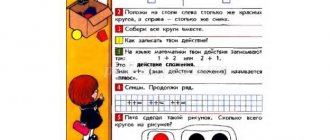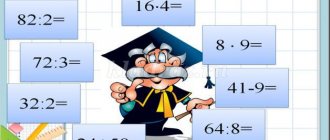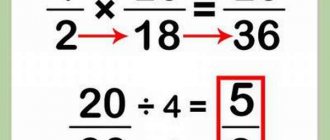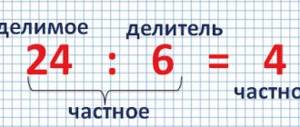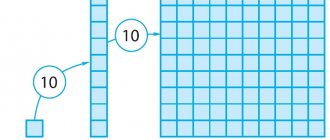Number 10. Formation of number 10
Do you love the circus? I'm sure so! In today's lesson I invite you to a circus performance. Look who will be performing there.
Let's count everyone:
- strongman - one;
- equilibrist (skillfully maintains balance when riding a bicycle or standing on wobbly objects) – two;
- juggler – three;
- clown – four;
- mime (makes people laugh using gestures and facial expressions) – five;
- tightrope walker - six;
- trampoline player (shows tricks on a trampoline) – seven;
- trainer - eight;
- acrobat - nine.
So, there are nine artists in total. But someone is missing here!
Of course, you can’t do a circus without a magician!
Can you tell me how many performers are in the circus now?
There were nine of them and now one more has been added. Do you remember how we taught that if you add one more to a number, you get the next number? The number nine has the next number ten .
Let's count all the artists again:
- strongman - one;
- equilibrist – two;
- juggler – three;
- clown - four;
- mime - five;
- tightrope walker - six;
- trampoline player - seven;
- trainer - eight;
- acrobat - nine;
- magician - ten.
Now we have only ten artists.
The rule for forming the number ten is as follows: add one to nine .
Practice counting within ten. Look at the next picture. There are balls, hats and juggling sticks. Determine which items are ten. To avoid confusion when counting, pay attention to the color of the objects.
Now we need to remember the ordinal count within ten:
- strongman - first;
- tightrope walker – second;
- juggler – third;
- clown - fourth;
- mime – fifth;
- tightrope walker - sixth;
- trampoline player - seventh;
- trainer - eighth;
- acrobat - ninth;
- magician - tenth.
Now independently determine the number of objects that the magician took out of the hat, and then count them in order.
Tell me, what did he get fifth? What about the eighth?
Writing the number 10
It's time to get acquainted with the form of writing the number ten. It should be written like this:
Have you noticed that the number ten is written differently from all the other numbers we have learned before? What's special about it?
That's right, this number is written not with one, but with two digits at once. You guessed the number 1 and the number 0. But in the number 10 they must be written together.
The recording of the number 10 is similar to the attributes of our magician. His empty hat reminds us of a number and the number 0. And the magic wand can be compared to the number 1.
Since we use two digits to write the number 10, this number is called two-digit .
The numbers we were introduced to earlier are written using a single digit. Therefore, they are usually called unambiguous . These are 1, 2, 3, 4, 5, 6, 7, 8, 9, 0.
The number 10 is the first and smallest two-digit number.
In your notebook you should write the number 10 like this:
The numbers 1 and 0 must be written side by side in two adjacent cells. Please note that when writing the number 10 , the number 0 should be written on the left side of the cell, starting from the middle of the upper border of the cell.
Remember how we learned to write these numbers and practice writing the number 10 yourself.
Remember! 10 is a number, and it is written with the numbers 1 and 0.
Math lesson “Number and figure 10” (1st grade)
Number 10
Goals:
- Form an idea of the number 10, get acquainted with the composition of this number, prepare students for studying the topic “Two-digit numbers”; strengthen counting skills within 10.
- To develop basic mental operations (memory, attention, speed of reaction, flexibility and variability of thinking), creative abilities of the student.
- Cultivate interest in the subject, a sense of responsibility and mutual assistance, respect for comrades.
Equipment:
Presentation
,
projector, screen, task diagrams.
I. Organizational moment.
Greetings.
- Let's welcome our guests. Let's get ready for work, give each other smiles, so that we have a good mood and a charge of vigor. I am glad that we are ready for the lesson, for communicating with each other.
(Slide 2)
– Guys, do you like fairy tales? – Would you like to visit a fairy tale now? Tsvetik-seven-flowered will help us get there
with his magic words.
(Slide 3)
- Fly, fly petal, Through the west to the east, Through the north, through the south, Come back, making a circle. As soon as you touch the ground, you are told to do it our way. They told us to find ourselves in a fairy tale.
2. Updating knowledge
(Slide 4)
– What fairy tale are we in? (Swan geese)
- Let's help Mashenka find her brother.
- Let's see how attentive you are! Look at the screen. (Slide 5)
1, 4, 7, 5, 6, 3, 9
– Read a series of numbers. What task can you offer?
– Make up various sums and differences using these numbers.
(7 – 1 = 6, 9 – 6 = 3, 3 + 4 = 7, 3 + 6 = 9, 4 + 5 = 9, etc.)
- Well done, but let’s return to Mashenka. The girl rushed to catch up with the geese-swans, and on the way she met Pechka. (Slide 6)
- Stove! Stove! Tell me, where did the geese-swans fly? – Complete my tasks, I’ll tell you. Here is the stove's task.
(Slide 7)
– Write these numbers in ascending order.
1, 3, 4, 5, 6, 7, 9
– Have you received a segment of the natural series? (No. You need to insert the numbers 2, 8.)
– Write down a segment of the natural series below: (Slide 7)
1, 2, 3, 4, 5, 6, 7, 8, 9
– What do these numbers have in common? (Unambiguous).
– What groups can they be divided into? (Even and odd).
- Name the even numbers. Odd.
– Write down these numbers in descending order. (Slide
9, 8, 7, 6, 5, 4, 3, 2, 1
– Now verbally add the numbers of the first and second row. What did you notice? (We get the number 10 every time
.)
– Write this number on the next line. Mashenka began to write down this number and thought about it. What do you think about? Who wrote down the number in one cell? Who's in two squares?
2. Report the topic of the lesson.
– What do you think we have to figure out in class? What we're going to talk?
– Today, helping Mashenka, we will learn how the number 10 is formed, we will learn to write it correctly, we will study the composition of this number and practice counting.
Discovery of something new.
– Mashenka completed the task and ran on. He sees an Apple tree standing. (Slide 9)
- Apple tree! Apple tree! Tell me, where did the geese-swans fly?
“If you complete my task, I’ll tell you.”
1) Introducing the number 10.
- Let's turn to our textbook. (P. 60) Apple tree asks what do we know about the number 10?
– Where is 10 located in the number line and on the number line? (After 9).
– How to get 10? (Add 1 to 9).
– How else can you write 10? What kind of symbols do you have on your page? (x – Roman numeral, 10 dots in the form of a triangle).
– The number 10 was a symbol of harmony and completeness in ancient times. Ten became the basis
decimal counting system used all over the world.
– How does the number 10 differ from those studied? ( Double digit
)
Zero rolled across the page and meant nothing. One stood nearby, making ten of him.
– Masha found out about the number 10 and ran further, she saw a milk river flowing, the banks of jelly. (Slide 10)
- Milk river, jelly banks, where did the swan geese fly? “If you complete my task, I’ll tell you.” - Let's help the girl! The river told Mashenka to learn to write the number 10. - How many digits are required to write this number? – How many cells are needed to write the number 10?
2) Explanation of writing the number 10.
(Slide 11)
- Let's see how the number 10 is written. Follow the magic pencil with your eyes.
– The number 10 is written in two boxes using numbers 1 and 0, Number 1 is written in the right half of the box and number 0 in the right half of the box.
– Let’s get our fingers ready for work.
Warm up your fingers before work.
I roll the pen in my hand and twirl it between my fingers. I will certainly teach every finger to be obedient.
– Write down the number 10 in your printed notebook.
3) Composition of the number 10
– Mashenka, thanks to you, learned to write the number 10 and ran further after her brother! (Slide 12)
Suddenly he sees a hut standing on chicken legs, turning around.
- Let's help my sister turn the hut around! What is the number of the hut? (10)
“The hut asks us to return to our notes and conduct an observation.” (Slide 13)
– The composition of the number 10 is written here. How many examples do you think you should remember?
(Only five, since the rest are repeated.)
- Write them down in the first column.
- Check yourself. (check on screen) (Slide 14)
– What pattern do you see?
(If one number is increased by 1, the other is decreased by the same amount, and the result remains unchanged.)
- Well done! We completed the task, but in order for the hut to let Mashenka in to pick up her brother, she gives another task. (Slide 15)
(p.60 examples)
– What do you think the authors wanted to offer us in this task? What parts can the figures in the picture be divided into? What parts does the number 10 break into?
– Write down in the second column for each partition all possible numerical equalities,
(Each row has its own pattern).
- Check yourself. (Slide 16)
– Name the whole and parts in each expression. How to find the whole? How to find the parts?
4. Primary consolidation.
- With your help, Mashenka rescued her brother and they ran home. And Baba Yaga sent the Geese-Swans in pursuit. The girl and her brother ran to the milk river. (Slide 17)
The girl turned to the river: “Mother River, hide me!” – If you complete my task, I’ll hide it. – The river wants to check how you have mastered the composition of the number 10.
Disk "Mathematics 1st grade". Numbers from 1 to 10 Numbering. Number 10. 1 task “Composition of the number 10”
.
5. Physical education moment.
- While the river hides Mashenka and Ivanushka, you and I will rest.
Jumping. (Jump as many times as the number is short of).
10 is 9 yes… 8 is 4 yes… 9 is 6 yes…. 7 is 5 yes...
- Now our eyes can rest
A physical exercise for the eyes.
Our little eyes are tired. We will let them rest: One, two, three, four, five - We will blink our eyes. (Slide 18)
Don’t turn your head, follow the leaf Up, down, right, left. Just use your eyes.
6. Repetition of what has been learned.
1) Problem solving.
- While we were resting, Mashenka and her brother ran far away, and the geese-swans were flying close again, about to overtake them! The children see that there is an apple tree. (Slide 19)
The girl turned to her for help, and the apple tree answered:
– If you complete my task, I’ll hide it. (Slide 20)
– 5 geese are flying above you, the same number are behind the clouds.
– What question can I ask?
(Answer quickly, how many geese were there?)
– How did you understand the expression “as much behind the clouds”? (That means 5)
– Write down only the solution to the problem!
5 + 5 = 10 ( g.)
– Yablonka has prepared a task for you. Mathematics 1st grade, 14 matem
(Pervologo, “Calculate and color”).
2) Working with expressions.
– You completed the tasks, and the apple tree covered the children! Geese and swans flew past. – The girl and her brother ran again. And the geese-swans are catching up, and look, they’ll snatch your brother out of his hands! The girl ran to the stove. (Slide 21)
- Mother Oven, hide us!
– Complete my task and I’ll hide it. (Slide 22)
- The stove invites everyone to choose a task according to their strength. Think about which column you can handle, write it down in your notebook and find the unknown numbers.
8 – 4 = 6 – 3 = 3 + 5 + = 10 4 + 3 = 10 10 – 3 – = 5 10 – – 4 = 3
- Check yourself. (Slide 23)
- The geese-swans flew, screamed and flew away to Baba Yaga with nothing. And the girl and her brother returned home to their parents! (Slide 24)
- It's time for us to return from the fairy tale!
- Let's say magic words! (Slide 25)
Fly, fly petal, Through the west to the east, Through the north, through the south, Come back, making a circle. As soon as you touch the ground, we want you to do it our way!
- Order us to be in our class! (Slide 26)
7. Lesson summary.
– Did you like participating in the fairy tale? – What does this fairy tale teach? (Help people in trouble, listen to parents)
– What did we learn in the lesson?
(Slide 27 Well done!)
Self-esteem.
– Evaluate your help to Mashenka and your work in the notebook.
The one who draws a red square in the margin is
- who actively helped her all the time, worked hard, made no mistakes, and is pleased with himself.
Green
– did a good job, but there were some inaccuracies.
Blue
- we still need to try harder.
Composition of the number 10
The main skill a magician needs is sleight of hand. With his hands he can move objects without touching them, pull objects out of the air, and much more.
How many fingers are there on both hands of a magician? Correct 10.
How did you know he has 10 fingers?
That's right, you have 10 of them too. Now we will learn the composition of the number 10 .
Place your hands in front of you. Count how many fingers are on one hand. And then on to the second. What did you get?
That's right, five fingers on one hand and five fingers on the second.
So 10 is 5 and 5.
Now let's look at other combinations. Just count your thumbs.
There are 2 of them. How many other fingers are there? That's right, 8.
So 10 is 2 and 8.
Now count all the fingers of your left hand and the thumb of your right hand together.
It turned out to be 6. How many fingers are left on your right hand? Exactly, 4.
So 10 is 6 and 4.
Now show the “ok” sign and count how many fingers are sticking up and how many are pinched.
It turned out 3 and 7.
So 10 is 3 and 7.
Everything is fine. We've covered all the combinations!
Let's definitely not forget that 9 and 1 are also 10. We learned this when we became acquainted with the order in which the number 10 is formed .
Let's now repeat and generalize everything again.
10
9 and 1 or 1 and 9
8 and 2 or 2 and 8
7 and 3 or 3 and 7
6 and 4 or 4 and 6
5 And 5
To better remember the composition of the number 10, complete the task. In this picture, find all the pairs of numbers that make up the number 10 .
Remember the composition of the number 10 more often by counting your fingers. This knowledge will be very useful to you in the future when solving complex examples.
Sequence of numbers within 10
So, we have learned the numbers from 0 to 10. They are called natural numbers. Each number indicates the number of elements in a particular set.
Look at the pictures and determine which set each number corresponds to.
Look, here are the numbers we learned.
7 3 5 2 4 1 0 9 6 10 8
Did you remember all the numbers? Let's check. Next to each number, draw the corresponding quantity.
circles.
This is what happened to me. Check your drawings.
Great. You know all the numbers. But it is important to remember that there is a certain sequence of numbers that cannot be violated when counting objects. I think that this order is already familiar to you.
Look again at this series of numbers and place them in the correct sequence.
7 3 5 2 4 1 0 9 6 10 8
Now let's check. This is what should happen.
0 1 2 3 4 5 6 7 8 9 10
The numbers are arranged in ascending order, i.e. Each next number is greater than all previous ones. This sequence of natural numbers is based on the rule for forming numbers within 10 . You already know him.
If we add one more to the previous number, we get the next number.
From here we get the opposite rule.
If you subtract one from a number, you get the previous number. Therefore, each number is less than all subsequent ones.
Now you can use your knowledge of the sequence of numbers to compare numbers. For example, 5 comes after the number 3, which means 5 is greater than three. And 7 comes before 10, which means 7 is less than 10. Practice composing inequalities yourself by looking at a series of natural numbers.
Here's a more difficult task for you: try counting in reverse order. This helps you better remember the sequence of numbers within ten.
I'm sure you did it. Let's check: ten, nine, eight, seven, six, five, four, three, two, one. That's right, well done.
Now try to restore the order of the numbers by naming the missing numbers.
Check it out.
Well done. I hope you remember everything and will soon be able to start learning new numbers.
Counting poems for teaching counting
One, two, three, four, five - I can count everything: And the sleds on the mountain, And the strollers in the yard, And the girls, and the boys, Their sisters, and brothers, And the counters in the grocery store, And the windows in our house.
One, two, three, four, five - I can count everything, Except stars and moths, Except grass and clouds, Except jumping raindrops And spring ringing ice floes...
I don’t feel like counting them: I might lose count! (M. Plyatskovsky)
The donkey’s mother taught him to count: “There is one tail, start repeating.” The donkey stubbornly nodded his head: “What do you think? After all, the tail is mine!”
“He’s yours, he’s yours, but, after all, he’s alone!” “There’s only one tail,” the son agrees. "Finally! How many ears? Well, don’t be stubborn, count quickly!”
The donkey thinks: “Here is one ear, Here is the second: two ears! Funny!". “What's so funny? Now look: A tail plus two ears makes three!”
“How many legs? Help me count! Only the front ones have two legs!” “With the back ones, quickly add two of them, How much will it be? Come on, tell me!”
The donkey thought: “How many legs?” “You’re counting something slowly, son! Add two more to your two legs!” “There will be four,” the donkey answered her.
“Next, son, we continue to count: Legs plus a tail will turn out...?” "Five!". “If you put the legs and ears together, how much will it be, donkey? Tell!".
“It’s easy to count the legs and ears: Two plus four makes six!” Then the mother began to praise the donkey: “Can you put it all together with a tail?”
“Donkey, there’s not much left at all: Put it all away! And it will work out...?” "Seven!". “Donkey, well, are you stubborn again?” “Mom, I have nothing left to count!”
“The legs are counted, the ears and the tail are counted. What's left there?" “Add more nose!” “How much can you get with a nose, son?” "Eight! I’ve already counted everything I could!”
"Is that all? What about the eyes? There are two of them too! And, of course, one head! “If you fold the head and legs, add eyes and ears,
“That’ll be nine!” “That's right son! You could handle arithmetic! Donkey, in order for us to go further in the count, we need to get to ten.
“So, let’s continue: two ears and a nose, four legs, two eyes and a tail, finally put it all together!” “That’ll be ten!” "Well done!".
“Donkey, as you see, the problem is simple. Next time we'll count to one hundred! (A. Goltseva)
A fox walked along the edge of the forest: One - a strawberry in a basket, Two - a blueberry like the sky, Three - a ruddy lingonberry, And four - a cloudberry, Five - a little currant, Six - a viburnum like a bead, Seven - a rowan like the sun, Eight - a blackberry in its paw , Nine is blue blueberries, Ten is juicy raspberries. Here's a full basket!
Training and education of children with mental retardation using a correction program
One - hand, two - hand - We are making a snowman! Three - four, three - four, Let's draw a wider mouth! Five - let's find carrots for the nose, Find coals for the eyes. Six - let's put our hat on askew. Let him laugh with us. Seven and eight, seven and eight - We will ask him to dance. Nine, ten - snowman Over the head - somersault! What a circus!
